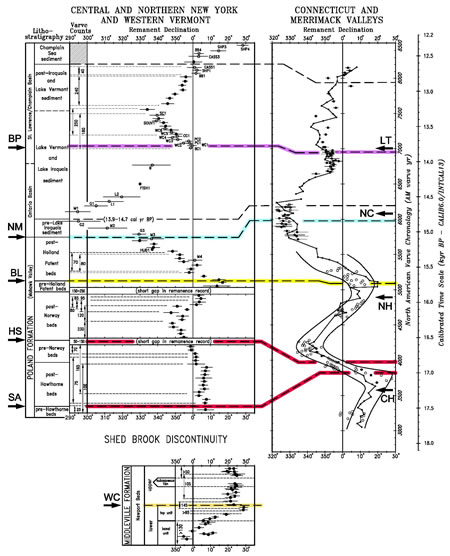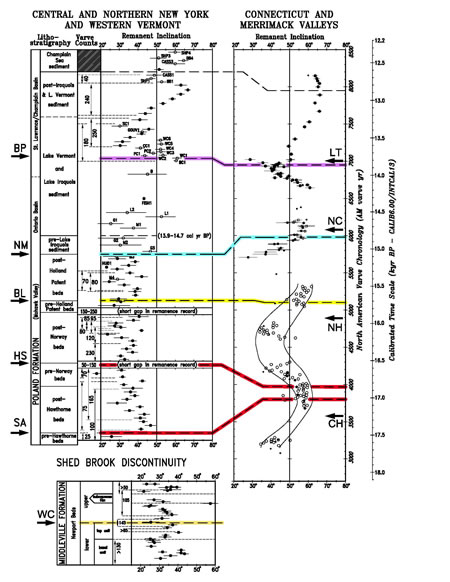Paleomagnetism and the NAVC in the Northeastern U.S.
Across the northeastern U.S. the paleomagnetism of varved glaciolacustrine sequences provides additional stratigraphic information that has been useful for regional correlation and testing the ages of stratigraphic units. Parameters such as remanent declination and inclination have been measured along with remanence intensities, bulk susceptibility, and anisotropy of susceptibility from oriented samples collected at many localities (See Field Methods � Paleomagnetism). Several areas have been the focus of this work including the Connecticut and Merrimack valleys in New England and the western Mohawk, Champlain, and St. Lawrence Valleys of New York and western Vermont.
Paleomagnetic work on varves in the Connecticut Valley was among the first on sedimentary deposits and was the first to use a varve chronology time scale (Antevs' original NEVC) to obtain a detailed paleomagnetic record (McNish and Johnson, 1938; Johnson et al., 1948). A secular variation curve of remanent declination was produced as well as a few inclination values. This work was later verified for the lower Connecticut varve sequence of the NEVC by Verosub (1979a, 1979b) who applied laboratory treatments to natural remanent magnetization measurements to test their stability. Later work in New England has focused on extending the records of the lower Connecticut varves and verifying and extending results for the Connecticut and Merrimack Valley varve sequences (Ridge et al., 1996, 1999, 2001). In 2010 the paleomagnetic records were re-plotted for the North American Varve Chronology numbering system, which is what is shown here. Paleomagnetic records also provide information useful for identifying where to look for potential matches between outcrop records and existing varve chronologies. The New England paleomagnetic records have been correlated to records from New York and western Vermont. The correlation of remanent declination records across the region, along with the radiocarbon calibration of varves, has allowed the correlation of ice-recessional positions and deglaciation events as part of a comprehensive reconstruction of the pattern of deglaciation (See NAVC and Deglaciation). These correlations are important because most varve sequences in New York have not been measured and there are presently few correlations between New England and New York based on the matching of varve sequences, although such correlations are likely in the future, especially for areas of the Hudson and Champlain valleys. Regional paleomagnetic correlations have also allowed the application of calibrated ages of the NAVC ( See NAVC calibration) to events from central New York to Maine.
Remanent Declination
Shown below is a plot of remanent declination records from varves of the NAVC in the Connecticut and Merrimack valleys. Data from these New England records is from Johnson et al. (1948; small dots connected with line), Verosub (1979a; open circles and envelope), Ridge et al. (1999; Conn. Valley, solid circles with error bars) and Ridge et al. (2001; Merrimack Valley, squares with error bars). The NAVC declination record is correlated to records from western Vermont and New York. This correlation is expected given the close proximity of the two areas. Regional constraints on deglaciation dictate that the two declination records must significantly overlap in time. In addition, the correlation shows a match of an extreme westward maximum in declination (to 40-60° W) on both records (15.0-14.6 cal kyr BP) where there are similar radiocarbon measurements from both records. Data in New York is not plotted against a varve chronology and varves have not been matched to the NAVC. The New York records have been assembled according to relative age based on superposition in single exposures and stratigraphic sequences and the regional time constraints placed on glaciolacustrine sequences by the pattern of deglaciation and lake impoundment at various stages of ice recession. Data in New York are from Ridge et al. (1990; western Mohawk Valley's pre-Hawthorne to post-Holland patent beds, solid circles), Brennan et al. (1984; Mohawk Valley and Ontario Basin, open circles), Pair et al. (1994; St. Lawrence Basin, open circles), and Ridge et al. (1999; Champlain Valley, solid circles). Data shown with error bars are vector mean values of 10-12 samples clustered within 20-30 varve years. The error bars represent 95% spherical confidence intervals (α95) about the means. Abbreviations and colored lines represent the times of the maximum extent of glacial readvances in New York: SA = Salisbury Readvance, HS = Hinckley/St. Johnsville Readvance, BL = Barneveld/Little Falls Readvance, and NM = Ninemile Readvance in the western Mohawk Valley, and BP = Bridport Readvance in the Champlain Valley. See Ridge (2004) or NAVC and Deglaciation for the geographic positions of these readvances.

Remanent declination records from varves of the NAVC in the Connecticut and Merrimack valleys. Click to download full-resolution version (~3MB).
Remanent Inclination
Unlike remanent declination, remanent inclination has not been a useful parameter for regional correlation in the varve sequences of the northeastern United States and adjacent Canada. Remanent inclination values do not vary as much as declination and are subject to flattening by depositional and post-depositional processes. Using the alignment of the remanent declination records from New England and New York a plot of remanent inclination values is shown below for the comparison of inclination records in both regions. Data is shown with the same symbols and sources as on the declination record. There does not always appear to be a pattern in inclination variation in New York that matches the record in New England, especially in the western Mohawk Valley record. This is likely due to flattening of inclination during deposition and then again under extreme compaction as most Mohawk Valley measurements were from sediment compressed by overriding ice and large lithostatic loads (Ridge et al., 1990). Up section steepening of inclination in several single outcrops is also suggestive of the influences of up section changes in lithology and compaction rather than solely a reflection of changes in geomagnetic inclination at the sites.

Remanent inclination records from varves of the NAVC in the Connecticut and Merrimack valleys. Click to download full-resolution version (~1.5MB).
References
- Brennan, W.J., Hamilton, M., Kilbury, R., Reeves, R.L., and Covert, L., 1984, Late Quaternary secular variation of geomagnetic declination in western New York: Earth and Planetary Science Letters, v. 70, p. 363-372.
- Johnson, E.A., Murphy, T., and Torreson, O.W., 1948, Pre-history of the earth's magnetic field. Terrestrial Magnetism and Atmospheric Electricity (now Journal of Geophysical Research), v. 53, p. 349-372.
- McNish, A.G. and Johnson, E.A., 1938, Magnetization of unmetamorphosed varves and marine sediments. Terrestrial Magnetism and Atmospheric Electricity (now Journal of Geophysical Research), v. 43, p. 401-407.
- Pair, D.L., Muller, E.H., and Plumley, P.W., 1994, Correlation of late Pleistocene glaciolacustrine and marine deposits by means of geomagnetic secular variation, with examples from northern New York and southern Ontario. Quaternary Research, v. 42, p. 277-287.
- Ridge, J.C., 2003, The last deglaciation of the northeastern United States: A combined varve, paleomagnetic, and calibrated 14C chronology, in Hart, J.P. and Cremeens D.L., eds., Geoarchaeology of Landscapes in the Glaciated Northeast U.S.: New York State Museum Bulletin 497, p. 15-45.
- Ridge, J.C., 2004, The Quaternary glaciation of western New England with correlations to surrounding areas, in Ehlers, J. & Gibbard, P.L. (eds.), Quaternary Glaciations � Extent and Chronology, Part II: North America. Developments in Quaternary Science, vol. 2b, Amsterdam, Elsevier, p. 163-193.
- Ridge, J.C., Brennan, W.J., and Muller, E.H., 1990, The use of paleomagnetic declination to test correlations of late Wisconsinan glaciolacustrine sediments in central New York: Geological Society of America Bulletin, v. 102, p. 26-44.
- Ridge, J.C., Thompson, W.C., Brochu, M., Brown, S., and Fowler, B.K., 1996, Glacial Geology of the Upper Connecticut Valley in the Vicinity of the Lower Ammonoosuc and Passumpsic Valleys of New Hampshire and Vermont, in M.R. Van Baalen (ed.), Guidebook to Field Trips in Northern New Hampshire and Adjacent Regions of Maine and Vermont, 88th Annual Meeting: New England Intercollegiate Geologic Conference, Harvard University, Cambridge, Massachusetts, p. 309-339.
- Ridge, J.C., Besonen, M.R., Brochu, M., Brown, S.L., Callahan, J.W., Cook, G.J., Nicholson, R.S., and Toll, N.J., 1999, Varve, paleomagnetic, and 14C chronologies for Late Pleistocene events in New Hampshire and Vermont, U.S.A.: G�ographie physique et Quaternaire, v.53, p. 79-108.
- Ridge, J.C., Canwell, B.A., Kelly, M.A., and Kelley, S.Z., 2001, An atmospheric 14C chronology for Late Wisconsinan deglaciation and sea level change in eastern New England using varve and paleomagnetic records: in Weddle, T. and Retelle, M., Deglacial History and Relative Sea-level Changes, Northern New England and Adjacent Canada: Geological Society of America Special Paper no. 351, p. 171-189.
- Verosub, K.L., 1979a, Paleomagnetism of varved sediments from western New England: Secular variation: Geophysical Research Letters, v. 6, p. 245-248.
- Verosub, K.L., 1979b, Paleomagnetism of varved sediments from western New England: Variability of the recorder: Geophysical Research Letters, v. 6, p. 241-244.


